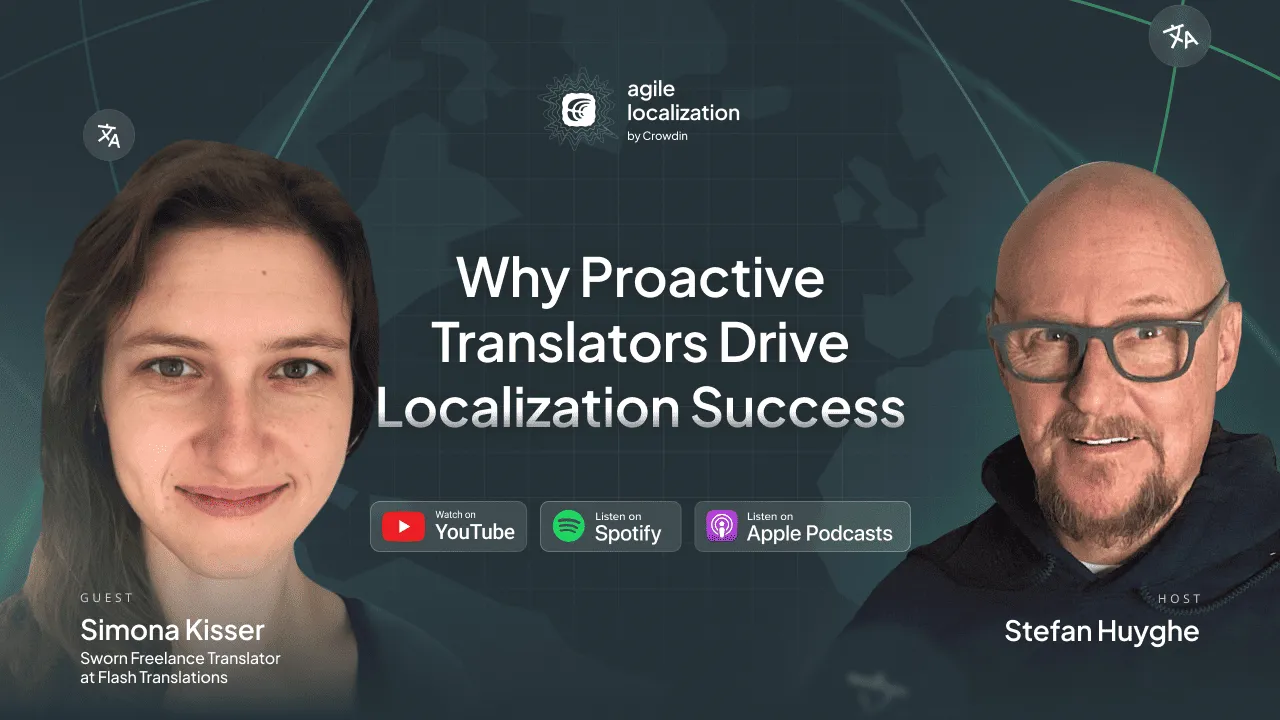Speed and accuracy in localization can mean the difference between delighting a user and losing them entirely. Agile localization has transformed how language professionals work.
But while much of the focus has been on enterprise tools and large-scale vendor operations, freelance translators are carving out their own space, leveraging technology to deliver high-quality results while building lasting client relationships.
On a recent episode of The Agile Localization Podcast, host Stefan Huyghe sat down with Simona Kisser, a technical translator and software localization specialist, to talk about the evolving role of freelance linguists. From the importance of context to the art of balancing speed and quality, Simona shared practical insights from over a decade in the field.
Listen to the new episode on:
Why Context Is a Translator’s Best Friend
One of Simona’s strongest messages is that translation quality depends on context. Too often, translators are given isolated strings without the background to interpret them correctly.
In software localization, a single word like Start could mean “start the program” or “go back to the start”, two different instructions. Without seeing the user interface (UI) or knowing the intended function, translators are forced to guess, which risks errors and poor user experience.
Localization platforms like Crowdin have made strides here, embedding UI previews, screenshots, and character limits directly into the translation environment.
Mastering Placeholders, Variables, and Tags
Technical translators frequently work with placeholders that must remain intact while still fitting the syntax of the target language. For languages like German, where sentence structure differs significantly from English, this requires careful reordering of the text.
Simona stresses that placeholders must not only be preserved but also placed naturally. Having access to tools that make placeholders visible and editable in context saves time and avoids awkward phrasing.
Favorite Features for Quality and Consistency
While translation memory (TM) and glossaries are standard tools, Crowdin’s search functionality is one of Simona’s favorites. It allows her to quickly locate previous translations of tricky phrases, even across projects from different years.
She also enjoys being able to see translations in other languages, not copy them, but to spark inspiration. Sometimes reading how a Spanish or French translator solved a problem helps her find the perfect German equivalent.
For brand consistency, in-context glossary integration is crucial. Instead of sifting through spreadsheets, translators can see approved terminology for each string instantly. Crowdin also shows how often a term has been translated in different ways, helping teams align on the best choice.
Building Long-Term Client Relationships
For freelancers, strong relationships are built on responsiveness, reliability, and care. Simona often starts as “just the translator,” but over time, she becomes a trusted part of the product team.
One example: when translating product names from English to German, she noticed that measurements in inches wouldn’t resonate with German users. Instead of translating literally, Simona suggested alternatives, sparking a conversation within the client’s team about how to better localize product names for the market. It’s this proactive approach that keeps clients coming back.
Freelancers vs. Agencies
While agencies can offer scalability, working directly with a freelancer has distinct advantages for clients:
- Direct communication without a middleman, leading to faster clarifications.
- Consistency: The same person handles all translations, ensuring tone and terminology stay aligned.
- Product familiarity: Over time, the translator develops deep knowledge of the product and brand.
Freelancers must also plan for scalability by maintaining a trusted network of peers to handle overflow or emergencies. This ensures clients are never left stranded if the freelancer is unavailable.
Key Takeaways for Freelance Translators
- Push for context: UI previews, screenshots, and background details improve both speed and quality.
- Master the technical side: understand placeholders, variables, and platform features.
- Be proactive: ask questions, flag issues, and suggest improvements to source copy.
- Build trust: reliability and care turn one-off jobs into long-term partnerships.
- Leverage technology: use glossaries, TM, and cross-language inspiration to stay consistent.
- Plan for overflow: maintain a network to ensure client needs are always met.
Final Thoughts
Freelance translators in agile localization are more than just wordsmiths; they’re integral team members bridging cultures, markets, and technologies. Embracing the tools, workflows, and relationships that agile demands allows translators like Simona to prove that independent linguists can thrive and even lead in this landscape.
Simona’s Background
Simona Kisser is a freelance technical translator and localization specialist with over 10 years of experience, specializing in software localization and technical translations from English to German. With a background in industrial engineering and specialized translation training, she has developed expertise in delivering high-quality technical and software translations while maintaining brand consistency across markets.
Listen to the new episode on:
Yuliia Makarenko
Yuliia Makarenko is a marketing specialist with over a decade of experience, and she’s all about creating content that readers will love. She’s a pro at using her skills in SEO, research, and data analysis to write useful content. When she’s not diving into content creation, you can find her reading a good thriller, practicing some yoga, or simply enjoying playtime with her little one.
